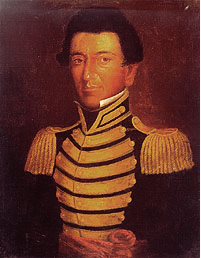Juan Nepomuceno Seguin was born on October 27, 1806 in San Antonio, Texas. His ancestors were founding members of San Antonio and had prominent roles in the beginnings of Texas’ settlement. Seguin’s great-great grandfather, Pedro Ocon y Trillo, served as alderman in the town council during the 1760s. Santiago Seguin, Juan’s grandfather began the ranching tradition in the Seguin family and became one of San Antonio’s principle cattle exporters at the end of the 1770s. Erasmo Seguin, Juan Seguin’s father, was a part of the counterrevolt during the Mexican War for Independence in 1810. From the beginning, the Seguin family was invested in the well-being of the San Antonio community and the Texas settlement. Juan Seguin, himself, became an influential Tejano figure during the Texas Revolution; however, despite a long history of dedication to the well-being of the Texas settlement, he was faced with false accusations despite his endless display of patriotism and efforts that supported the Texian cause for independence. He was a military captain, in charge of his own command primarily made up of other Tejano soldiers.1 He was a politician receiving the titles such as alderman in 1828, alcade in 1833, then becoming the first Tejano to serve in the Republic of Texas Senate in 1837.2 Most importantly, he was a Tejano achieving these great feats in an Anglo-dominated Texas during the nineteenth century. These accomplishments put him under intense scrutiny. Because of the scrutiny Seguin faced, it is important to remember his legacy as a Tejano hero who made many sacrifices for the health of the Texas settlement. One should read sources from either his Mexican or Anglo contemporaries with caution due to their negative biases towards Tejanos. There were many racial tensions between the Tejanos (Mexicans residing in Texas), Mexicans, and Texians (Anglo settlers in Texas) during the time of the Texas revolution. Juan Seguin, with his numerous accomplishments as a Tejano during the nineteenth century, faced these racial tensions from both the Mexicans and Texians primarily due to his position of power, often with the intent to slander his name and image.

To understand why these racial tensions were so prominent, it is important to understand that Tejano was not a word that existed in the nineteenth century. To the Mexicans and Texians, Juan Seguin was still a Mexican. To the Mexicans, Seguin was a traitor to his country, and to the Texians, despite his continuous display of patriotism, he was still a Mexican and should be looked at suspiciously. Seguin knew of these views he was faced with on both sides, as he stated, “The rumor, that I was a traitor, was seized with avidity; by my enemies in San Antonio. Some envied my position, as held by a Mexican; others found in me an obstacle to the accomplishment of their villainous plans.”3 Having a Mexican in such a high-ranking position made people on both sides uneasy—for the Mexicans, they did not want a traitor in power and for the Texians, they did not want someone with ancestral ties to the enemy nation in such power.
From the Mexican side of hostilities, Seguin knew of rumors coming from Mexican sources. In Seguin’s memoir, he tells of a time in which Chevallie, a Texian revolutionary escaped from imprisonment by the Mexicans, told Seguin about some of the rumors he heard while in captivity.
In combination with the Mexican’s attempt to tarnish Seguin’s reputation, the Texians were trying to mar his image as they did not want a Mexican to hold such a great amount of power. Among the rumors of his disloyalty to Texas, Seguin felt threatened and decided to leave Texas and seek refuge in Mexico, where he thought he could retire among his family in Saltillo. Seguin states, “Chevallie told me that Vasquez [of the Mexican army] and his officers stated that I was on the side of the Mexicans.”4 Another Mexican soldier only known as Sanchez, showed Chevallie a letter claiming that Seguin wrote it, while stating, “Seguin is with us.”4 The goal of this was to convince the Texians that while Seguin seemed to be patriotic to the revolutionary cause, he was secretly working with the Mexicans to go against the Texians’ cause at the same time.
Matters being in this state, I saw that it was necessary to take some step which would place me in security and save my family from constant wretchedness. I had to leave Texas, abandon all for which I had fought and spent my fortune, to become a wanderer. The ingratitude of those who had assumed onto themselves the right of convicting me, their credulity in declaring me a traitor on the basis of mere rumors, the necessity to defend myself for the loyal patriotism with which I had always served Texas, wounded me deeply.6
However, once in Mexico, interesting events took place with what seemed to be another attempt from Mexico to slander Seguin’s name. While Seguin wanted to live in Saltillo where he could be close to his relatives, Santa Anna instead wanted him to go to Mexico City.7 However, there was an alternate, more devious plan that Santa Anna devised. Santa Anna decided to allow Seguin to live in Saltillo under the condition that Seguin join the Mexican military and attack Texas citizens.8 This would have shown the Texians that Seguin might have been on the Mexican’s side all along just as the rumors had claimed, or this could have demonstrated, in general, that Tejanos were vulnerable to switching sides. After this event, Texas Ranger Ben McCulloch called Seguin a traitor and compared him to Benedict Arnold.9 From the beginning, the Mexicans wanted to ruin Seguin’s reputation among the Anglos, and with the requirement to make him serve in the Mexican army, it solidified their plan.

Seguin’s reputation was so tarnished, that he published his memoir in 1858 to explain his side of the story in hopes that people would listen and show empathy towards him. Seguin returned to San Antonio after the Mexican-American War ended in 1848 and lived in Texas until 1867, until racial tensions caused him to move to Mexico for the final time, where he lived out the rest of his life until August 27, 1890. When remembering Juan Seguin and other Tejanos in powerful positions, it is important to be aware that many sources are biased due to the racial tensions present during the time. Despite the label he received by his Mexican and Anglo counterparts as a traitor, today Juan Seguin can be labeled as a Texas hero due to his unyielding loyalty to the Texas settlement.
- Jesus F. de la Teja, A Revolution Remembered: The Memoirs and Selected Correspondence of Juan N. Seguín (Texas State Historical Association, 2002), 20. ↵
- Encyclopaedia Britannica, 2016, s.v. “Juan Seguin: Tejano Revolutionary and Politician.” ↵
- Juan N Seguin, as cited in de la Teja, A Revolution Remembered, 101. ↵
- Juan N. Seguin, as cited in de la Teja, A Revolution Remembered, 94. ↵
- Juan N. Seguin, as cited in de la Teja, A Revolution Remembered, 94. ↵
- Juan N. Seguin, as cited in de la Teja, A Revolution Remembered, 96. ↵
- Juan N. Seguin, as cited in de la Teja, A Revolution Remembered, 97. ↵
- Juan N. Seguin, as cited in de la Teja, A Revolution Remembered, 97. ↵
- Ben McCulloch to William W.S. Bliss, June 23, 1846, Ben and Henry Eustace McCulloch Family Papers, 1798-1961, Dolph Briscoe Center for American History, The University of Texas at Austin. ↵



35 comments
Sergio Cervantes
Although I am not a native of San Antonio, it is interesting to read about the history of the life of an individual who was as a patriotic as any other Texan, but still looked upon with suspicion based on his ancestral roots. The struggles he faced from surviving wars to being labeled as a traitor prove how strong this man was. It is saddening to read that he had to move around constantly to escape the false accusations that were placed against him.
Aaron Jaramillo
Being born and raised in San Antonio this article was very interesting to me. It was also interesting to me how Texians and Mexicans wanted to break down Seguin’s reputation. In my opinion Seguin wasn’t a trader. His race and power he was just trying to help both the Texians and the Mexicans. Overall, well written and well organized article. Good job Mariana.
Tina Valdez
As a San Antonio native I found your article very interesting. I thought it especially important your note at the end of your article regarding biased sources. You provided a great deal of information and organized it well. I for one can certainly see why Seguin can be labeled a Texas hero. Thank you for sharing this article.
Christian Lozano
Being a native San Antonian and a descendant of Mexicans, this article really speaks to me about the trials and tribulations of early Mexicans in Texas, especially those like Juan Nepomuceno Seguin, for whom we owe much to today.
Maalik Stansbury
I can’t believe the amount of discrimination Seguin suffered. Really Texans and Mexicans had to be so mean. I really enjoyed the article. The amount of description put into the suffrage of Seguin was well-done, including the explanatory of how it was done so. I really thought you did a good wiht this article. I liked it.
Mia Diaz
Awesome article! It is always fascinating to learn more about San Antonio’s history, and the people who used to live here. It is so sad to learn that such a brave individual was forced to abandon his principles and be viewed as an outsider just because of his mixed cultural heritage. Even though the biases of the time were a common occurrence, it is still very unfortunate to hear about how the hatred and jealousy of others can cause such a dreadful impact to someone’s life and their reputation. I think this article did a great job of exposing all the facts and giving credit to a man who definitely deserved it!
Ivanna Rodriguez
Awesome article! It was interesting to learn about a historical figure from San Antonio. What intrigued me the most was how both the Mexicans and Texians wanted to tarnish Seguin’s reputation. The Texians didn’t want to acknowledge his position or loyalty to Texas. Extremely well-researched. Keep it up.
Andres Palacios
I am not from San Antonio and I certainly don’t know much about it’s history but It is always nice to learn about history specially from the place I currently live in. In my opinion I don’t think Seguin Was a traitor he was just following the foot steps of his family and what he believed in. He had a big effect in the settlement of the city of San Antonio and that’s how he should be remembered not as a traitor.
Trey Whitworth
Good article! I remember leaning about Juan Seguin as a child, but I never realized that he faced prejudice from both Texans and Mexicans on account of being a Tejano. In hindsight, it makes sense, but I never thought about it until now. I also didn’t know that he eventually moved to Mexico.
Yesenia Cardenas
Although I have lived in San Antonio my entire life, I have never really known much about its history. In my personal opinion, I do not believe he was a traitor. He was judged by others simply by his race. This was a very informative article and I hope to learn more in the near future.